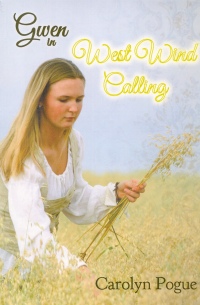| ________________
CM . . . . Volume XIX Number 5 . . . . October 5, 2012
excerpt:
In Gwen (Sumach, 2009)(Vol. XVI, No. 27, March 19, 2010), Carolyn Pogue wrote a story inspired by her grandmother, a "Home" child, one of the over 100,000 poor children exported from Britain to the dominions, principally to Canada. Their story has been documented in Kenneth Bagnell's The Little Immigrants, and elsewhere. Pogue's historical knowledge was integrated smoothly into the novel, and her plucky heroine, Gwen Peters, lingered in readers' minds after the novel had ended. West Wind Calling, the sequel, can stand alone and be enjoyed by those who haven't yet read Gwen. At the end of the first novel, after some bad experiences, Gwen was living happily with the Browns near Brantford, ON, and making friends among the native people on the nearby reserve. West Wind Calling opens in 1898 with a funeral service for Mr. Brown and baby Reg. This social ordeal stirs up Gwen's memories of her father's death in England, an event which led to her being sent to Canada. The shock of Mr. Brown's loss is worsened by the violence surrounding his death. He was beaten by thugs who were selling liquor and stealing lumber on the native reserve. A few weeks later, infant Reg succumbed to influenza. Thirteen-year-old Gwen pulls herself together to help Mrs. Brown, who is numb with grief. When Mrs. Brown decides to move to Calgary to look for employment, Gwen insists on coming along to look after her. In West Wind Calling, as in Gwen, Pogue uses the journey plot structure to introduce interesting characters who each exemplify some aspect of Canadian life in the late 19th century. By settling her two main characters in a low rent, fixer upper house on the Bow River outside Calgary, Pogue puts them in a location where they will encounter people on the fringes of society, discriminated against and looked down upon. Pogue shows a harmonious society in microcosm when they help each other and become friends. Readers are gratified, too, when Mr. Brown's killers are caught. Gwen had admired Canadian poet/performer E. Pauline Johnson (a real person) ever since seeing her on stage in London, England. Throughout West Wind Calling, Gwen quotes Johnson's narrative poems, using them to interpret her new experiences in the west. The poems not only serve as a unifying device, but also elevate the novel and give it another dimension. Gwen's love for Johnson's work shows how literature can enhance everyday people's lives. Slightly jarring, however, is Gwen's tendency to sum up a situation as if it were a play starring herself; for example, "London Girl Learns to Move Like a Shadow on the Pathless Prairie" (page 108) and "London Orphan Becomes Real Westerner" (page 130). Is this tendency typical of a creative person? Is it desirable? As an "early published" child with writing ambitions, I was usually too engaged in whatever was going on to step back from it and see it as raw material. Gwen's interjections are intrusive, but, fortunately, infrequent. The cover design of a traditionally published novel (in contrast to print on demand) is decided by the art and marketing departments, not the author. The cover of Gwen, designed around a childhood photo of Pogue's grandmother, was charming. The photo on the front of West Wind Calling shows a blonde beauty (older than thirteen) with flowing golden hair, standing waist high in wheat, gathering a bouquet of grain. The picture suggests that the novel will be a romance, when, in fact, it is a realistic work about social class, the Canadian mosaic, and life in a boom town. Will Gwen go on the stage as a warm up act for E. Pauline Johnson in the next novel? Time will tell. Highly Recommended. Ottawa, ON, resident Ruth Latta frequently uses her husband's art in the cover designs of her novels, though not in the most recent one, The Old Love and the New Love, (Ottawa, Baico, 2012, baico@bellnet.ca)
To comment
on this title or this review, send mail to cm@umanitoba.ca.
Copyright © the Manitoba Library Association. Reproduction for personal
use is permitted only if this copyright notice is maintained. Any
other reproduction is prohibited without permission.
NEXT REVIEW |
TABLE OF CONTENTS FOR THIS ISSUE
- October 5, 2012.
AUTHORS |
TITLES |
MEDIA REVIEWS |
PROFILES |
BACK ISSUES |
SEARCH |
CMARCHIVE |
HOME |
